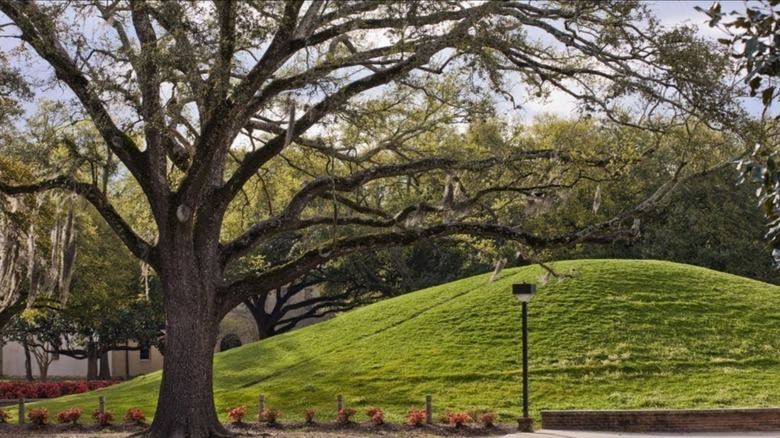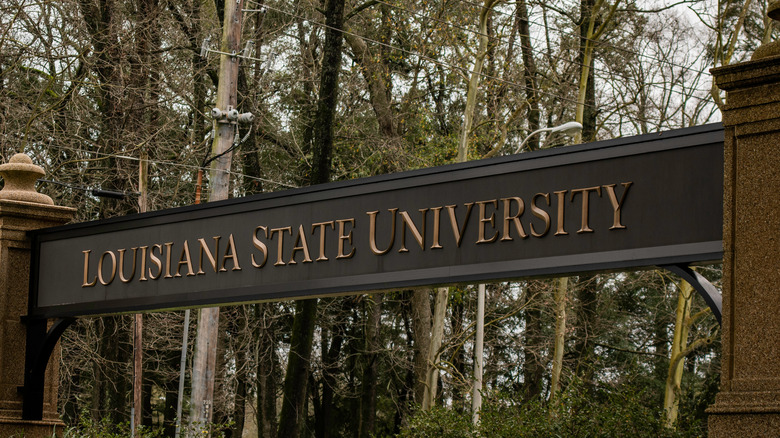Not Even The Egyptian Pyramids Are As Old As This Part Of LSU's Campus
Hidden in plain sight on the sunny campus of Louisiana State University, two inconspicuous-looking grassy mounds are set to re-write the history of early America. While they may not inspire the same level of awe as the ancient Pyramids at Giza, these humble earthwork mounds are more than twice as old. While you'd be forgiven for thinking that the gentle hills in question were simply modern landscaping features, according to LiveScience, the older of the two mounds (Mound B), is a staggering 11,000, years old — making it far older than the famous wonders at Giza, built a mere 4,500 years ago (via National Geographic).
While the great age of these ancient constructions was only discovered recently, the university has long been aware of their potential historical significance. According to the LSU, when the land in question was first bought by the university, those in charge took pains to ensure the earthworks remained intact during each subsequent expansion of the campus. Unfortunately, early attempts to evaluate the mounds yielded few results. An extensive modern study conducted in the early '80s, for example, incorrectly concluded that the earthworks were a measly 2,000 years old. Only in June of this year has geologist Brook Ellwood successfully revised that number, pushing the date back by a whopping 9,000 years.
Unraveling the mystery
But what, we may wonder, were these strange mounds used for? While, by and large, these structures remain a mystery, the core samples taken from the soil for radio-carbon dating have given us some tantalizing clues. Upon examination, pieces of bone and plant material extracted from the mounds have revealed that large fires were likely lit at these sites (via Reveille) — and they raged at very high temperatures.
It has also been suggested that the earthen mounds, thick with ash and clay, were built gradually over a number of years. The first of which (mound B), was in use between 11,000 to 8,200 years ago, while the second mound (mound A) was built around 7,500 years ago. According to LiveScience, some researchers believe that the infernos that burned here (far too hot for making food), may have served some religious function.
In the future, other clues regarding the reason behind their existence may come from similar sites elsewhere. While the LSU mounds may be the oldest, they are by no means the only examples of their kind in North America. Back in 1997, the Watson Brake mound (also located in Louisiana) was hailed as one of the oldest archaeological sites in North America (via The New York Times), created up to 5,000 years ago. These mounds and numerous others, make up a fascinating historic region across the deep south.
Protectors of the past
Today the LSU mounds are still of huge importance to modern-day Native Americans. Keeping the site pristine, however, has proven to be quite difficult. Forming part of an ancient landscape, a number of Louisiana's mounds, (such as those found at poverty point) are included in a series of historic trails advertised by the state of Louisiana's Department of Culture.
Louisiana State University has reported that the mounds have already been damaged by a slow trickle of curious travelers and casual walkers — and their newly discovered great age is only likely to increase the number of eager visitors. In order to preserve them for future generations, the university has established a committee to discuss future safeguards. In 2021, a fence was erected to keep away unwanted scramblers — and as of this year, a huge fundraising campaign is underway to educate the public and to protect this fascinating window into America's history (via Reveille).


